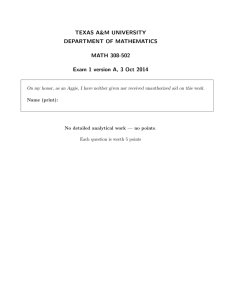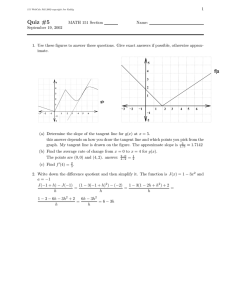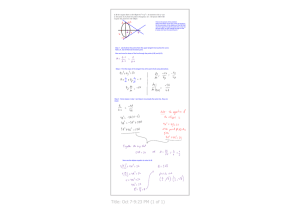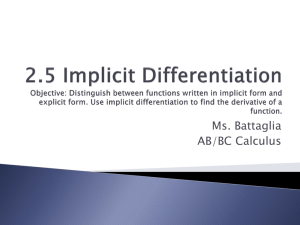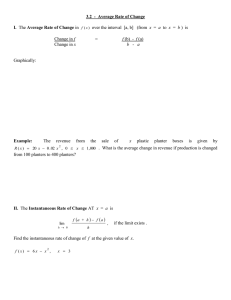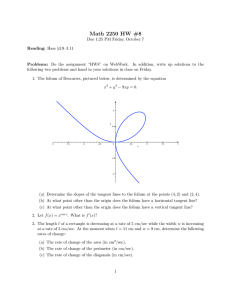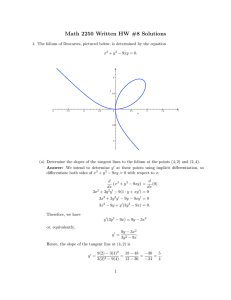Assignment 1 Math 110-003 Due Thurs Jan 14
advertisement
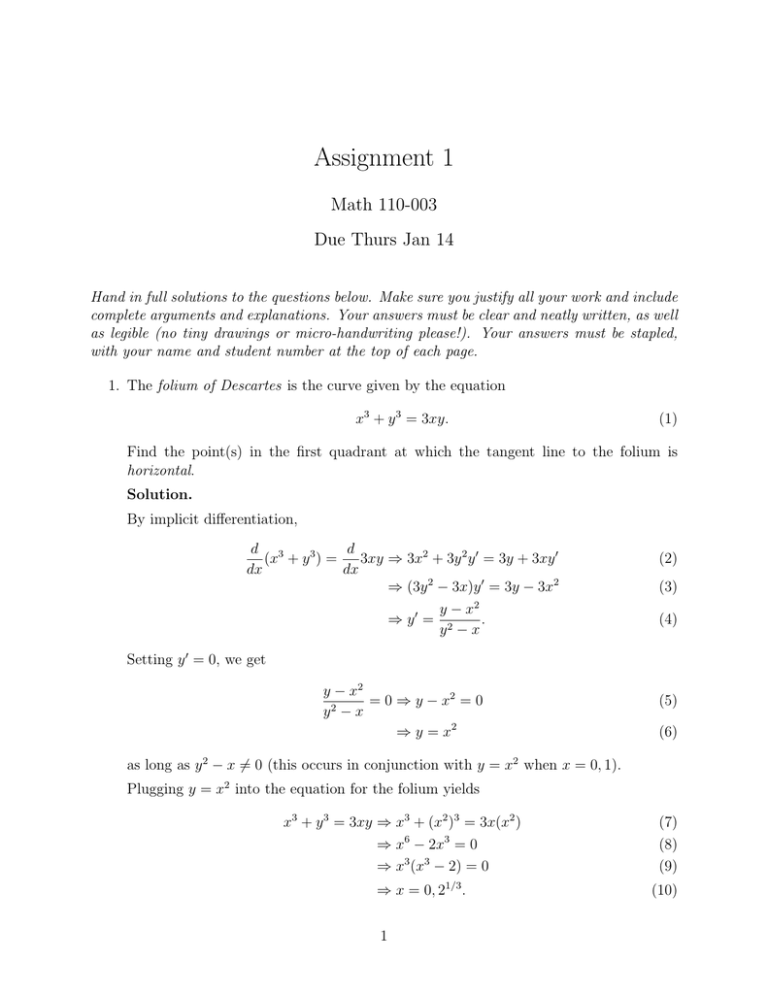
Assignment 1 Math 110-003 Due Thurs Jan 14 Hand in full solutions to the questions below. Make sure you justify all your work and include complete arguments and explanations. Your answers must be clear and neatly written, as well as legible (no tiny drawings or micro-handwriting please!). Your answers must be stapled, with your name and student number at the top of each page. 1. The folium of Descartes is the curve given by the equation x3 + y 3 = 3xy. (1) Find the point(s) in the first quadrant at which the tangent line to the folium is horizontal. Solution. By implicit differentiation, d d 3 (x + y 3 ) = 3xy ⇒ 3x2 + 3y 2 y 0 = 3y + 3xy 0 dx dx ⇒ (3y 2 − 3x)y 0 = 3y − 3x2 y − x2 ⇒ y0 = 2 . y −x (2) (3) (4) Setting y 0 = 0, we get y − x2 = 0 ⇒ y − x2 = 0 y2 − x ⇒ y = x2 (5) (6) as long as y 2 − x 6= 0 (this occurs in conjunction with y = x2 when x = 0, 1). Plugging y = x2 into the equation for the folium yields x3 + y 3 = 3xy ⇒ x3 + (x2 )3 = 3x(x2 ) ⇒ x6 − 2x3 = 0 ⇒ x3 (x3 − 2) = 0 ⇒ x = 0, 21/3 . 1 (7) (8) (9) (10) As noted above, we can ignore x = 0 so the only solution is x = 21/3 . To find the corresponding y-coordinate, plug this value of x into the relation y = x2 obtained above to get y = 22/3 . We conclude that the tangent line is horizontal at (x, y) = (21/3 , 22/3 ). 2. Show, using implicit differentiation, that any tangent line at a point (x0 , y0 ) to a circle with centre the origin (0, 0) is perpendicular to the line joining (0, 0) to (x0 , y0 ). Hint: First find the slope of the tangent line to the circle at (x0 , y0 ). Next find the slope of the line joining (0, 0) to (x0 , y0 ). Recall that a circle of radius r centered at the origin is given by the equation x2 + y 2 = r 2 . (11) Solution. By implicit differentiation, d 2 d 2 (x + y 2 ) = r ⇒ 2x + 2yy 0 = 0 dx dx x ⇒ y0 = − . y (12) (13) Thus, the slope of the tangent line to the circle at (x0 , y0 ) is −x0 /y0 . On the other hand, the perpendicular line joining (0, 0) to (x0 , y0 ) has slope Since y0 − 0 y0 = . x0 − 0 x0 (14) y0 x0 = −(− )−1 , x0 y0 (15) we conclude that these two lines are perpendicular to one another. 3. If f and g are twice-differentiable functions, show that (f g)00 = f 00 g + 2f 0 g 0 + f g 00 . (16) (f g)0 = f 0 g + f g 0 . (17) Solution. By the product rule, Differentiating once more (again with the product rule) gives (f g)00 = ((f g)0 )0 = (f 0 g + f g 0 )0 = f 00 g + f 0 g 0 + f 0 g 0 + f g 00 = f 00 g + 2f 0 g 0 g 00 . 2 (18)
